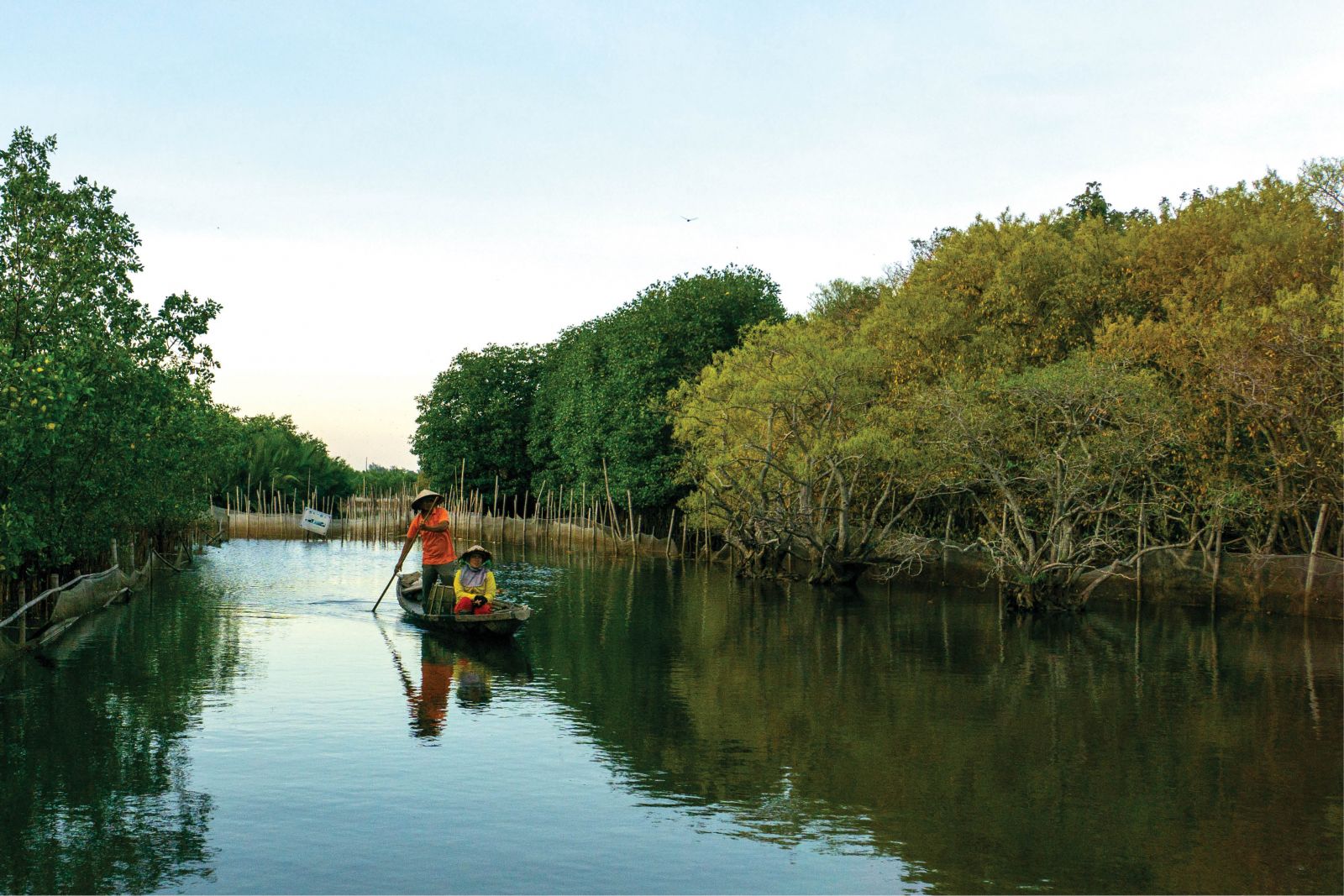
The expansion of Ru Cha mangrove forest area is under way
The screen for flood prevention
Located at the downstream end of the Perfume River, near Thuan An Estuary, Ru Cha is one of the few rare and precious primeval mangrove forests surviving in the country.
With an area of less than 4 ha, Ru Cha is like a wonderful and poetic natural picture. Apart from tourist value, this mangrove forest is also home to a lot of aquatic species in the lagoon.
This rare and valuable forest is also a screen for preventing floods, protecting crops and residents of Huong Phong Commune (Huong Tra Town) in the rainy season. Surrounding Ru Cha are the granaries of shrimp, fish, and abundant aquatic resources for the lagoon residents.
Awake to the role and importance, the forest protection branch together with the local authorities has expanded the area of mangrove forest around Ru Cha area to nearly 22 ha, including mangroves, aegiceras, nipas…
Chairman of the People's Committee of Huong Phong Commune, Mr. Tran Viet Chuc joyfully said, “Ru Cha is protected; the area is expanded; the aquatic resources multiply, and biodiversity is high. Thanks to fishing combined with aquaculture, many households around Ru Cha have settled down, many households have become well-off and made their pile. On average, each year, the whole commune earns about VND 40 billion from fishing and aquaculture. The fishermen's children can study, pass examinations…”
Dr. Pham Ngoc Dung, Deputy Director of Provincial Forest Protection Subdepartment judged that although with the area of only 3.83 ha not diverse in species, Ru Cha mangrove forest plays a vital role in the wetland ecosystem. This rare and valuable primeval forest is also a "green wall" that helps to reduce the damage caused by natural disasters, protect dykes and increase the response capacity to the impacts of climate change.
Currently, Ru Cha area is expanded by additional 18 ha, including mangroves, aegiceras…but is incommensurate with Tam Giang Lagoon’s potential and advantages. In the trend of environmental protection, the people, works under the influence of unpredictable climate change, storms and floods, Ru Cha area expansion is inevitable, promoting the socio-economic development not only for Huong Phong but also for many localities in the lagoon and coastal areas of the province.
Towards the multipurpose forest
Mr. Pham Ngoc Dung explained that Huong Phong Commune just about 13 kilometers from the city center, a few kilometers from Thuan An Town and the coastal communes of Phu Vang offers a great advantage for the expansion of Ru Cha in the service of the local socio-economic development.
This is also a land with great potential for ecotourism development for mangrove forests, water surface land of Tam Giang Lagoon with the advantage of abundant aquatic resources, water transportation, beautiful natural landscape, traditional revolutionary history, culture, folk festivals... Notably, mangrove forests and Tam Giang Lagoon water surface are two critical factors in promoting the ecotourism development in particular and socio-economic development of the localities in general.
The models of mangrove afforestation in Huong Phong Commune in recent years have shown that the species of plants suitable for this land such as aegiceras, nipas, and mangroves grow well. This provides the practical foundation for the plant species orientation for the project of the local mangrove forest development with more than 200 ha in the near future.
The species of plants selected for concentrated afforestation include mangroves, nipas... To build a gene museum of typical mangrove plants in Vietnam, the project will organize the collection and planting of about 50 main species of mangroves, typical of the North, Central and South Vietnam, including the above-mentioned concentrated mangrove species and new species.
The formation of the largest mangrove forest in the Central Coast creates favorable conditions for many economic sectors to join in the management and use of mangrove forest, the development of tourism and services. It also opens up new opportunities to enhance the value of agricultural and forestry production, contributing to sustainable economic growth for Huong Phong and surrounding areas.
There was the enterprise that applied for a license to invest in the construction of a tourist area and resort in Ru Cha area. Here, the investor will build a system of restaurants, hotels... for accommodation, visiting mangrove forests; provide services to experience the life of residents in the river and Tam Giang lagoon area, combined with tours of historical, cultural relics, agricultural production ... in the locality and surrounding areas.
Expanding Ru Cha mangrove forest area in Tam Giang Lagoon creates conditions for restoring and creating more breeding grounds and spawning grounds for aquatic species. The mangrove forest belts along the shore of Tam Giang Lagoon and the Perfume River (Thuan An estuary area) are the places to nurture and protect the larvae against the disadvantages of weather such as high wave and fierce wind and to provide feed for many economically valuable aquatic species. The natural breeding grounds for aquatic species are also formed.
This vast mangrove forest also protects aquatic creatures from high tides and huge waves. Many creatures living in caves, or on the muddy surface such as groupers, snails... will climb up plants to avoid waves when facing adverse weather and return to their old home when the wind is quiet and tide is out.
The mangroves planted on the sides of aquaculture ponds are capable of handling the waste from leftover food, excreta, shrimp shells, crabs, and fish from aquaculture ponds, contributing to environmental clean-up.
The foliage of mangroves planted around the pond both creates shadow and considerably limits the amount of pond water evaporated when it is hot, which does not result in the sudden increase in the temperature and salinity of the pond water and in the shock of the bred aquatic species.. The health of aquatic species bred in extensive swamps near mangrove forests or in ponds with mangroves is often better than in open lagoons.
Story: Hoang The - Photo: Hoang Phuoc
